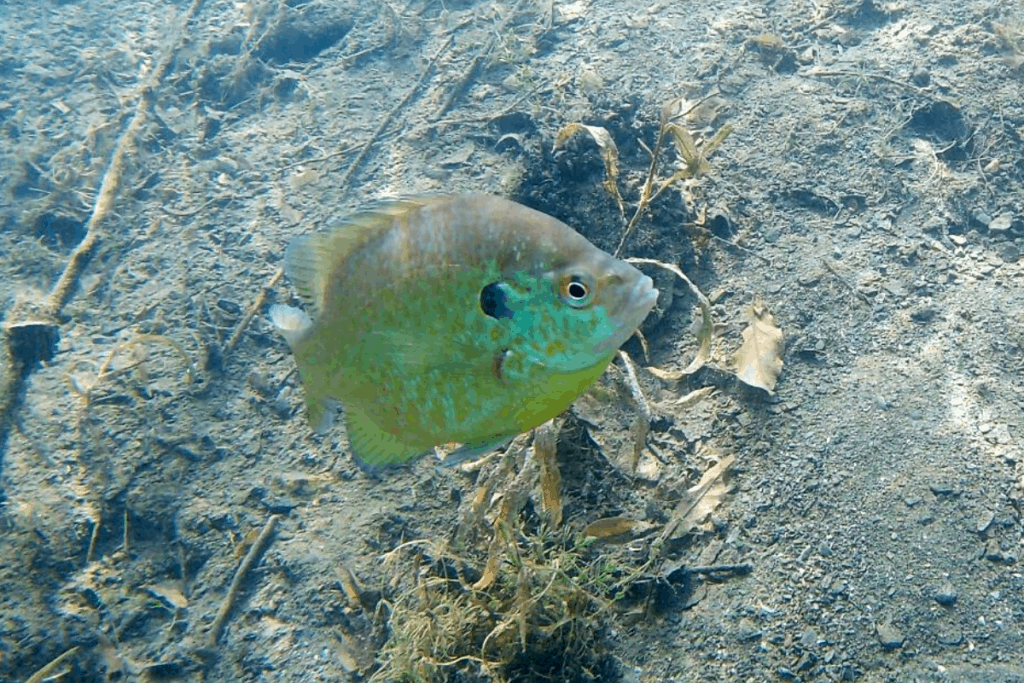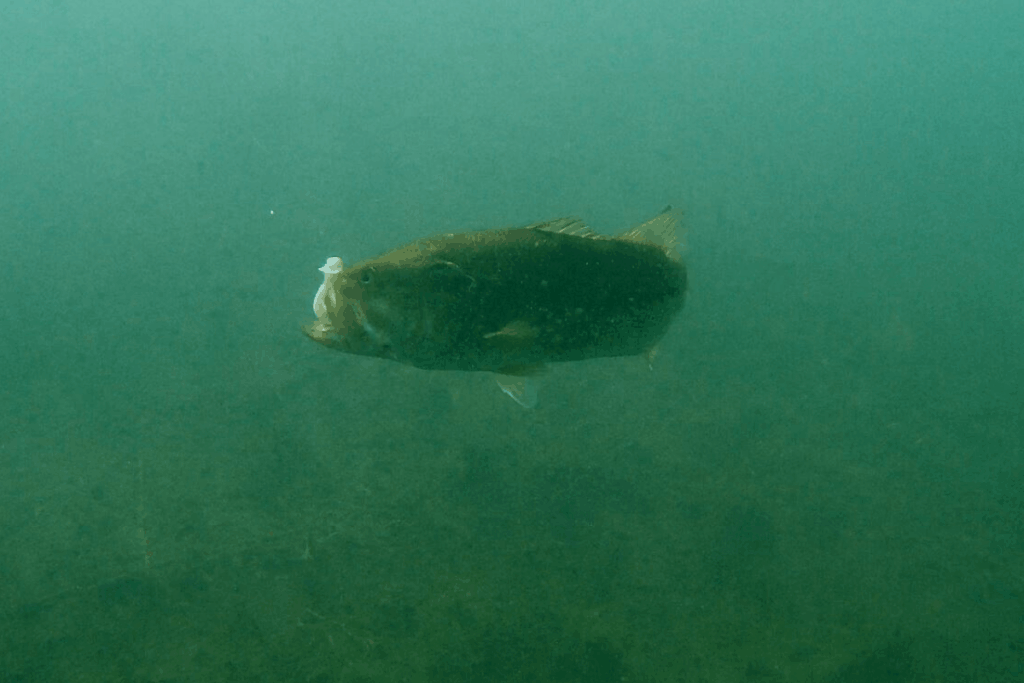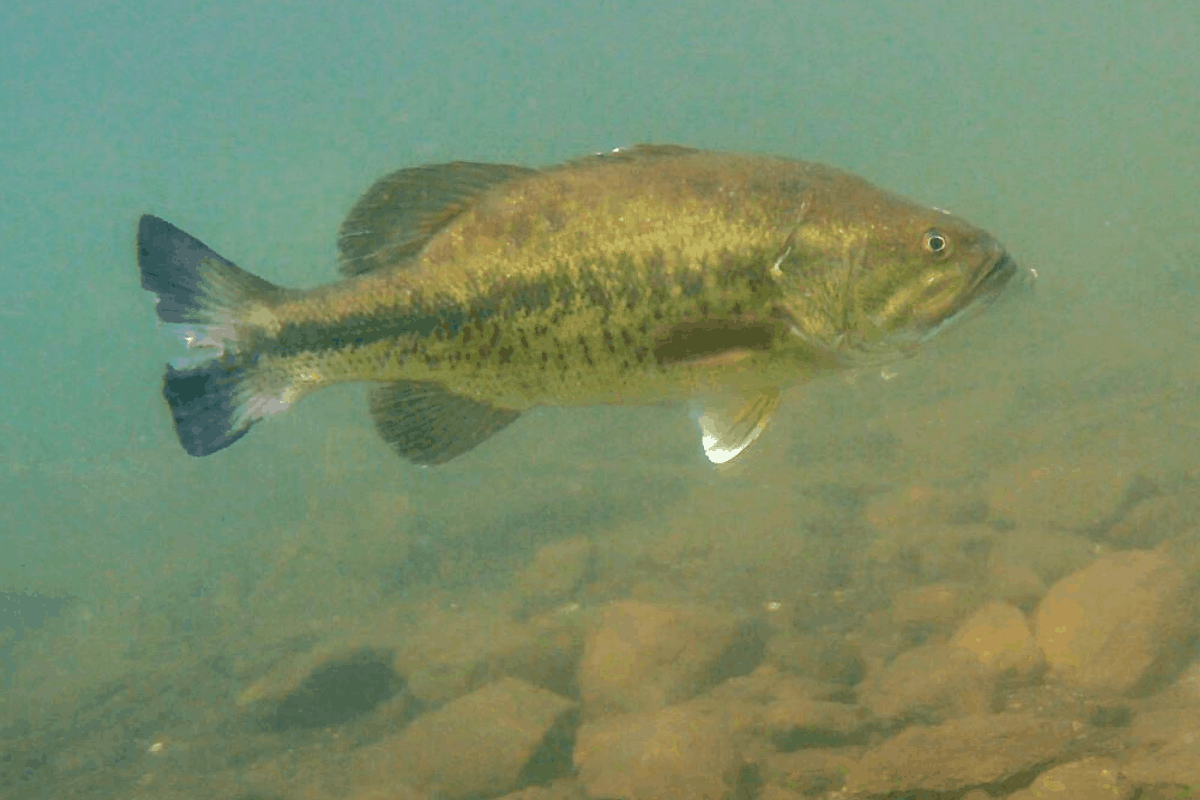Our life as anglers above the water is very different than what happens under it. We often have misconceptions of what is really taking place down there and how our favorite game fish behaves.
- It takes very little cover to hold bass.
- Forage species look much different under the water than they do out of it.
- Temperature varies tremendously throughout the water column.
- Baits presented in current can look quite unnatural
- Larger bass can inhale lures with almost no movement.
Spending time filming bass in their natural environment provides true perspective on fish behavior. This information is valuable when heading to the water.
The Smallest Cover Can Hold Bass
We have all seen it.
That single piece of cover sitting on a shoreline that is alone and seemingly yards away from anything meaningful. It is not unusual to move right past it and look farther down the shore to target a piece of cover that appears better.
I used to do the same thing.
The first time we took out the underwater camera to do some investigating a real lesson was learned. There was a small branch resting on the bottom of the lake. It had next to no other limbs and sat alone.
A patch of weeds covered the bottom near it, but they too were small and looked unimportant in regards to what a bass may desire as a refuge.
The underwater camera revealed something quite different. A pair of largemouth had chosen this spot to build a nest for the spawn. There were a million other areas that appeared to be a better choice for those of us looking down from above.
From the surface, this small limb was barely visible. In fact, all I could see was about three inches of the branch sitting a few feet under the surface. I had passed by this same spot hundreds of times and not once made a cast to it.
After this experience, I have made sure not to discount any piece of cover no matter how unimportant it looks.
Many times there may be no bass sitting there – but what if there is? It may even be your next personal best.

Forage Looks Very Different Underwater
I was utterly shocked at how brilliant forage can look under the water.
We know that sunfish have different amounts of red, yellow, blue and green. What I was not completely aware of is how intense the colors are in clear water when the sun hits them.
I watched one sunfish that would make any observer think that it was sitting on a reef in a tropical paradise. The colors were shockingly beautiful.
I now know that when matching the forage base I need to spend more time really thinking about what I am trying to mimic. This is especially true when fishing lakes and rivers with good visibility.
I have very few lures in my tackle collection that would even remotely imitate the stunning colors I witnessed. Keeping a few more variations of popular dye markers are now on my “must-have” list.
Dirty or Heavily Stained Water
When filming in water that has turbid conditions, the solid color patterns are much more visible as a whole.
Lures that have color variations and subtle differences in the silicone strands of a jig do not provide the more distinct profile of the solid black and white. Black-blue, as many anglers know, is also a solid dirty water option.
With that said, the distance at which these lures can be observed is much less than I originally thought.
In most cases, the profile is best seen within a few inches of the bait. When fishing dirty water, it is almost imperceptible from any distance greater than that.
So what does that mean?
Lures presented to targets in heavily stained water must be dropped close to a bass. In addition, baits that offer a sound-signature should be experimented with until the right tone that triggers strikes can be found.
Some days this may mean using loud tungsten rattles while other days may suffice with the vibrations caused by a soft plastic lure with wide appendages.
Variations in Water Temperature
If you have ever spent a summer day swimming in a lake, it is not a surprise that dangling toes can find cooler water.
I had no idea how cool the water gets and how fast that happens.
On a recent filming trip, the water temperature at the surface of the lake was a steamy 85°. At the twenty-five foot depth the temperature plummeted to a crisp 58°.
That is a massive difference.
Fish of all species can adjust their depth in just a few feet to find water that is most comfortable. While exploring the depths on this outing, it was discover that most of the sunfish, carp, and bass preferred to sit in the 15-20ft range.
While there was still life above and below that part of the water column, it was significantly less than that particular zone.
This reinforces the idea that when an angler finds and catches a single bass in the summer, there most likely will be many more in that same area.
It is easy to overlook a small 14” bass. We catch it, toss it back, and move on down the shore. That single bass could reveal a school of fish that may make for the best day you have ever had on the water.
Natural Presentations in Current is Critical to Catch Bass
When dealing with the heat of the summer, it is a favorite activity of mine to chase down smallmouth in rivers and streams.
Bass anglers have a good understanding of how fish relate to the current, but until I spent time watching lures travel with the flow underwater, I didn’t realize how easily a bait can look unnatural – thus turning off the fish.
Weight and line choice make a huge difference.
Too lite and a lure can tumble with the current at an unnatural pace that turns fish away. If a weight is too heavy it will not only sit fast when it should have some sort of movement, but it will likely get hung much easier and make for an inefficient day on the water.
It is also quite obvious, from under the water, that a lure working it’s way across the river can look terribly out of place. When witnessing baitfish, and even smallmouth, traveling across the current, they tend to slide slightly downstream as they move from one side to the other. Then when in a suitable location, they will move back upstream directly into the current if needed.
It is easy for anglers to cast to a shoreline and bring a lure across the current at a very unnatural angle.
The old mantra, cast upstream and let the lure drift downstream is true for a very good reason.
Think about how many casts we make on rivers that most likely never stand a chance to elicit a strike because of how unnatural they look with the current. Spending some extra time to position the boat properly to make the most natural presentation will yield many more strikes.

Big Bass can Inhale Lures with Ease
We all desire those arm-ripping strikes that nearly pull the rod from our hands.
The truth is, the bigger the fish the more subtle the bite can be.
While filming underwater, I have seen bass come up to a lure, flare its gills, and suck a bait right off the bottom with almost zero movement from the line.
This is also true for moving lures. A decent bass can come up to an offering like a swimbait and inhale it sideways. They then can nonchalantly swim off.
This type of footage has me thinking about how many bites we get that are never felt. The need for quality rods that can transmit the most subtle thump is apparent. Using a highly sensitive line, like braid, is a key component to feeling more bites as well.
I have always been a proponent of watching the line to see if it twitches or moves, but using a hi-vis color with a lo-vis leader almost seems a must.
Final Thoughts
The world under the water is quite different than what we think it is.
Hours of investigating life below the surface has revealed some interesting truths.
- Bass can hold on the smallest pieces of cover
- Forage species are very colorful in clear water
- Water temperature varies a lot throughout the water column
- Naturally presented lures in current is critical
- Big bass inhale lures with almost zero perceptible bite
Bass fishing is all about percentages. Fishing in high percentage areas with efficiency and natural looking offerings can stack the odds in our favor.
Tight lines. Be safe and make sure to go out and encourage someone today. You never know how you may change their life forever.
Isaiah 6:8

